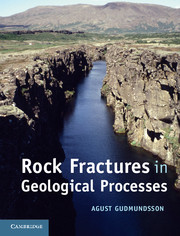Book contents
- Frontmatter
- Contents
- Preface
- Acknowledgements
- 1 Introduction
- 2 Stress
- 3 Displacement and strain
- 4 Relation between stress and strain
- 5 Loading of brittle rocks to failure
- 6 Stress concentration
- 7 Theories of brittle failure of rocks
- 8 Extension fractures and shear fractures
- 9 Displacements and driving stresses of fractures
- 10 Toughness and fracture mechanics
- 11 Field analysis of extension fractures
- 12 Field analysis of faults
- 13 Evolution of extension fractures
- 14 Evolution of faults
- 15 Fluid transport in rocks – the basics
- 16 Fluid transport in faults
- 17 Fluid transport in hydrofractures
- Appendix A Units, dimensions, and prefixes
- Appendix B The Greek alphabet
- Appendix C Some mathematical and physical constants
- Appendix D Elastic constants
- Appendix E Properties of some crustal materials
- Index
- References
8 - Extension fractures and shear fractures
Published online by Cambridge University Press: 05 June 2012
- Frontmatter
- Contents
- Preface
- Acknowledgements
- 1 Introduction
- 2 Stress
- 3 Displacement and strain
- 4 Relation between stress and strain
- 5 Loading of brittle rocks to failure
- 6 Stress concentration
- 7 Theories of brittle failure of rocks
- 8 Extension fractures and shear fractures
- 9 Displacements and driving stresses of fractures
- 10 Toughness and fracture mechanics
- 11 Field analysis of extension fractures
- 12 Field analysis of faults
- 13 Evolution of extension fractures
- 14 Evolution of faults
- 15 Fluid transport in rocks – the basics
- 16 Fluid transport in faults
- 17 Fluid transport in hydrofractures
- Appendix A Units, dimensions, and prefixes
- Appendix B The Greek alphabet
- Appendix C Some mathematical and physical constants
- Appendix D Elastic constants
- Appendix E Properties of some crustal materials
- Index
- References
Summary
Aims
Depending on the relative displacement across the fracture plane, all tectonic fractures are of two main mechanical types: extension fractures and shear fractures. In an extension fracture, the sense of displacement is perpendicular to, and away from, the fracture plane. In a shear fracture the sense of displacement is parallel with the fracture plane. To be able to distinguish between these two main types theoretically and in the field is of fundamental importance for understanding a variety of fracture-related problems and processes. These two types will be referred to many times in subsequent chapters. This brief chapter focuses on learning to recognise them in the field with reference to the basic theories for their formation discussed in earlier chapters. The main aims of this chapter are to:
Explain the mechanical difference between extension fractures and shear fractures.
Discuss the two main types of extension fractures, namely: (a) tension fractures, which are formed by absolute tension and usually close to the Earth's surface, and (b) fluid-driven fractures or hydrofractures, which are generated by fluid pressure and can form at any crustal depth.
Show that shear fractures comprise all faults as well as some fractures that are normally classified as joints in the field.
Provide field examples of the main mechanical types of fractures.
- Type
- Chapter
- Information
- Rock Fractures in Geological Processes , pp. 233 - 254Publisher: Cambridge University PressPrint publication year: 2011
References
- 2
- Cited by



